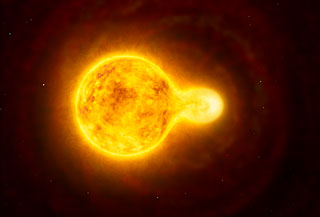This article is more than 1 year old
Forget superstars, this HYPERGIANT star is 1,300 times the size of OUR SUN
Try orbiting this: the largest yellow giant ever spotted
Pic Sixty years of professional and amateur observations have turned up a new surprise in the constellation of Centaur: a huge, heavy and bright monster that's the largest yellow star ever seen.
The hypergiant, HR 5171 A, has impressive vital statistics: the European Southern Observatory's Very Large Telescope Interferometer team estimates that it's equivalent to 39 solar masses, has a diameter 1,300 that of the Sun, and is about a million times brighter.
Let's get that diameter in perspective: drag-and-drop HR 5171 A in place of our sun, and it's good-bye to Mercury, Venus, Earth, Mars, the asteroid belt, Jupiter and Saturn.
The “A” in HR 5171 A indicates that it's part of a binary system, but only just: so big is the “A” of the pair, that it's in physical contact with its companion, which has a mere six solar masses and 400 solar radii. The companion is only 2.8 AUs from HR 5171 A, and their combined centre-to-centre distance is 10 AUs.
“The new observations also showed that this star has a very close binary partner, which was a real surprise,” says Olivier Chesneau, who led the analysis. “The two stars are so close that they touch and the whole system resembles a gigantic peanut.”

Artist's impression of the HR 5171 binary. Image: ESO
The hypergiant was analysed by linking a bunch of telescopes together, using interferometry to create the equivalent of a 140-metre telescope. As the ESO states: “Spectral data were obtained using the Anglo–Australian Telescope with the University College London Echelle Spectrograph (UCLES), at the South African Astronomical Observatory (SAAO), with PUCHEROS, from the Pontificia Universidad de Chile (PUC) and through coronagraphic observations with the Near-Infrared Coronagraphic Imager (NICI) on the Gemini South telescope.”
These observations were compared with photometric data from South Africa's Astronomical Observatory (dating from 1975 to 2013), and other datasets including amateur observations.
The ESO also notes that “HR 5171 A has been found to be getting bigger over the last 40 years, cooling as it grows, and its evolution has now been caught in action. Only a few stars are caught in this very brief phase, where they undergo a dramatic change in temperature as they rapidly evolve.”
If you're in the Southern Hemisphere and live somewhere there's not too much light pollution, HR 5171 A is just visible to the naked eye. Its magnitude varies between 6.1 and 7.3 depending on where the companion is in its orbit. ®
